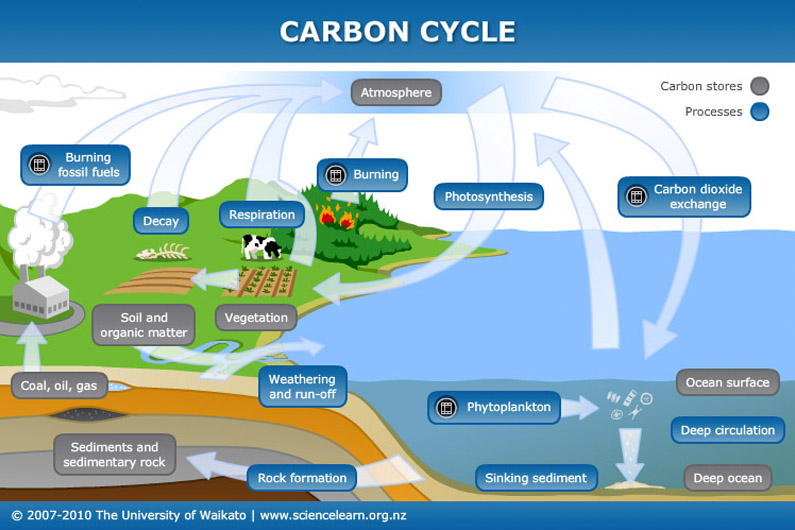SC.8.L.18.1 (Level 3) – Describe and investigate the process of photosynthesis, such as the roles of light, carbon dioxide, water and chlorophyll; production of food; release of oxygen.
SC.8.N.1.6 (Level 2) – Understand that scientific investigations involve the collection of relevant empirical evidence, the use of logical reasoning, and the application of imagination in devising hypotheses, predictions, explanations and models to make sense of the collected evidence.
SC.8.L.18.2 (Level 3)- Describe and investigate how cellular respiration breaks down food to provide energy and releases carbon dioxide.
SC.8.L.18.4 (Level 3) – Cite evidence that living systems follow the Laws of Conservation of Mass and Energy.
SC.8.L.18.3 (Level 3) – Construct a scientific model of the carbon cycle to show how matter and energy are continuously transferred within and between organisms and their physical environment.
SC.7.N.3.2 (Level 2) – Identify the benefits and limitations of the use of scientific models.
Advanced:
SC.912.L.18.7 – Identify the reactants, products, and basic functions of photosynthesis.
SC.912.L.18.8 – Identify the reactants, products, and basic functions of aerobic and anaerobic cellular respiration.
SC.912.L.18.9 – Explain the interrelated nature of photosynthesis and cellular respiration. 1. Identify the reactants, products, and basic functions of photosynthesis 2. Identify the reactants, products, and basic functions of aerobic and anaerobic cellular respiration 3. Explain the interrelated nature of photosynthesis and cellular respiration
|
• I am learning to describe the process of photosynthesis using word equations: o carbon dioxide + water + sunlight—> sugar (food) + oxygen + water
• I am learning to describe the role of light, carbon dioxide, water, and chlorophyll in photosynthesis.
• I am learning to identify organisms that contain chlorophyll and produce their own food also produce oxygen.
• I am learning to describe the process of cellular respiration using word equations: o oxygen + sugar(food) — > carbon dioxide + water
• I am learning to explain how cellular respiration breaks down food to provide energy and releases carbon dioxide and water as waste products.
• I am learning to explain why both plants and animals undergo cellular respiration as their energy source.
• I am learning to explain how living systems obey the Law of Conservation of Mass o NOS Focus – Design a controlled Experiment
• I am learning to explain how living systems obey the Law of Conservation of Energy
• I am learning to construct a scientific model to explain how matter and energy are transferred through organisms and their environment throughout the carbon cycle.
• I am learning to identify carbon reservoirs within the atmosphere, organisms, fossil fuels, sediments, oceans and other bodies of water.
Vocabulary:
Autotroph, biomass, carbon cycle, carbon reservoirs, cellular respiration, chemical equation, chlorophyll, chloroplasts, consumer, environment, fossil fuels, Law of Conservation of Energy, Law of Conservation of Mass, mitochondria, organism, autotroph, photosynthesis, photosynthetic, pollution, products, reactants, sediments, producer, heterotroph, decomposer
|
Daily Activities:
Day 1 (1/3) Unit 4 Introduction & Cells review (6th grade standard)
Preview Learning Targets
Day 2 (1/4) SMT 2
Day 3 (1/5 & 1/6) Photosynthesis reading passage, PPT w/notes
Day 4 (1/9) Gizmo Photosynthesis Lab & Doodle Notes
Day 5 (1/10) Photosynthesis project work time
Day 6 (1/11) Photosynthesis Project Due end of class
Day 7 (1/12 & 1/13) ( FAST Testing) Photosynthesis continued vocabulary review & Generation Genius
Day 8 (1/17) Bridge from Photosynthesis to Cellular Respiration
Day 9 (1/18) Cellular Respiration continued **Distribute Study Guides for DIA**
Day 10 (1/19 & 1/20) Begin Carbon Cycle
Day 11 (1/23) Carbon Cycle continued
Day 12(1/24) Carbon Cycle Flipbooks
Day 13 (1/25) Carbon Cycle Gizmo Lab
Day 14 (1/26 & 1/27) Carbon Cycle review & DIA Assessment
|




